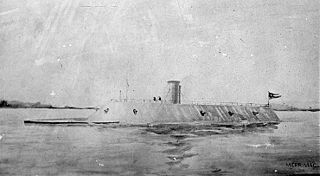
CSS Virginia was the first steam-powered ironclad warship built by the Confederate States Navy during the first year of the American Civil War; she was constructed as a casemate ironclad using the razéed original lower hull and engines of the scuttled steam frigate USS Merrimack. Virginia was one of the participants in the Battle of Hampton Roads, opposing the Union's USS Monitor in March 1862. The battle is chiefly significant in naval history as the first battle between ironclads.

CSS Texas was the third and last Columbia-class casemate ironclad built for the Confederate Navy during the American Civil War. Not begun until 1864 and intended to become part of the James River Squadron, she saw no action before being captured by Union forces while still fitting out. CSS Texas was reputed to have been one of the very best-constructed Confederate ironclads, second only to CSS Mississippi.

CSS Albemarle was a steam-powered casemate ironclad ram of the Confederate Navy, named for an estuary in North Carolina which was named for General George Monck, the first Duke of Albemarle and one of the original Carolina Lords Proprietor.

CSS Arkansas was the lead ship of her class of two casemate ironclads built for the Confederate States Navy during the American Civil War. Completed in 1862, she saw combat in the Western Theater when she steamed through a United States Navy fleet at Vicksburg in July. Arkansas was set on fire and destroyed by her crew after her engines broke down several weeks later. Her remains lie under a levee above Baton Rouge, Louisiana at 30°29′14″N91°12′5″W.

Franklin Buchanan was an officer in the United States Navy who became the only full admiral in the Confederate Navy during the American Civil War. He also commanded the ironclad CSS Virginia.

The Battle of Mobile Bay of August 5, 1864, was a naval and land engagement of the American Civil War in which a Union fleet commanded by Rear Admiral David G. Farragut, assisted by a contingent of soldiers, attacked a smaller Confederate fleet led by Admiral Franklin Buchanan and three forts that guarded the entrance to Mobile Bay: Morgan, Gaines and Powell. Farragut's order of "Damn the torpedoes! Four bells. Captain Drayton, go ahead! Jouett, full speed!" became famous in paraphrase, as "Damn the torpedoes, full speed ahead!"
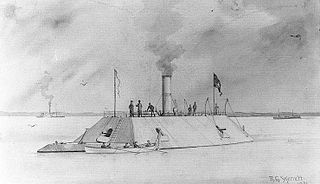
CSS Palmetto State was one of six Richmond class casemate ironclad rams built for the Confederate States Navy during the American Civil War. Completed in 1862, she defended Charleston, South Carolina and was burnt in 1865 to prevent her capture by advancing Union troops.

USS Hartford, a sloop-of-war steamer, was the first ship of the United States Navy named for Hartford, the capital of Connecticut. Hartford served in several prominent campaigns in the American Civil War as the flagship of David G. Farragut, most notably the Battle of Mobile Bay in 1864. She survived until 1956, when she sank awaiting restoration at Norfolk, Virginia.

CSSSelma was a steamship in the Confederate States Navy during the American Civil War. She served in the Confederate Navy first as Florida, and later as Selma. She was captured by the Union Navy steamer USS Metacomet during the Battle of Mobile Bay. She served as USS Selma until the end of the war, when she was decommissioned and sold for use as a merchant ship.
CSS Raleigh was a steam-powered Civil War casemate ironclad. She was fitted with a spar torpedo instead of an iron ram and was built in 1863–1864 by the Confederate States Navy at Wilmington, North Carolina. While she was being built her commander was Lieutenant John Wilkinson (CSN). She was put into commission on April 30, 1864 under the command of Lieutenant J. Pembroke Jones, CSN.
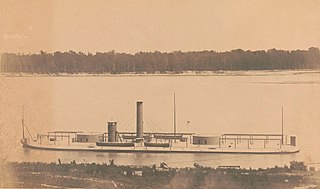
USS Chickasaw was an ironclad Milwaukee-class river monitor built for the United States Navy during the American Civil War. The ship participated in the Battle of Mobile Bay in August 1864, during which she was lightly damaged, and the bombardments of Forts Gaines and Morgan as Union troops besieged the fortifications defending the bay. In March–April 1865, Chickasaw again supported Union forces during the Mobile Campaign as they attacked Confederate fortifications defending the city of Mobile, Alabama.
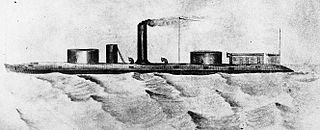
USS Winnebago was a double-turret Milwaukee-class river monitor, named for the Winnebago tribe of Siouan Indians, built for the Union Navy during the American Civil War. The ship participated in the Battle of Mobile Bay in 1864, during which she was lightly damaged, and the bombardments of Forts Gaines and Morgan as Union troops besieged the fortifications defending the bay. In early 1865, Winnebago again supported Union forces during the Mobile Campaign as they attacked Confederate fortifications defending the city of Mobile, Alabama. She was placed in reserve after the end of the war and sold in 1874.
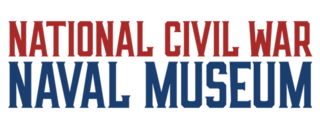
The National Civil War Naval Museum, located in Columbus, Georgia, United States, is a 40,000-square-foot (3,700 m2) facility that features remnants of two Confederate States Navy vessels. It also features uniforms, equipment and weapons used by the United States (Union) Navy from the North and the Confederate States Navy forces. It is claimed to be the only museum in the nation that tells the story of the two navies during the Civil War.

USS Octorara was a steamer acquired by the Union Navy during the American Civil War. She was used by the Navy to patrol navigable waterways of the Confederacy to prevent the Confederates from trading with other countries.
The order of battle for the Union and Confederate forces at the Battle of Mobile Bay on August 5, 1864.

CSS Huntsville was a Confederate ironclad floating battery built at Selma, Alabama, from 1862 to 1863 during the American Civil War.

CSS Tuscaloosa was an ironclad warship that served in the Confederate States Navy during the American Civil War. Construction began in May 1862, under a contract with Henry D. Bassett. Her engines were taken from the steamboat Chewala, and she was armored with 4 inches (10 cm) of iron and armed with four cannons. In January 1863, she was launched, and traveled down to Mobile, Alabama for service on Mobile Bay. Both Tuscaloosa and her sister ship CSS Huntsville were found to be too slow for practical use, and were relegated to service as floating batteries. Union forces captured Mobile in April 1865, and Tuscaloosa was scuttled on April 12, as she was unable to escape due to an inability to steam against the current on the Spanish River. Her wreck was discovered in the 1980s.
The Milwaukee-class monitors were a class of four riverine ironclad monitors built during the American Civil War. Several supported Union forces along the Mississippi River in mid-1864 before participating in the Battle of Mobile Bay in August. Chickasaw and Winnebago bombarded Confederate coastal fortifications during the battle and during subsequent operations as well as engaging the ironclad Tennessee II. The other two ships arrived at Mobile Bay after the battle and all four supported the land attacks on Mobile in March–April 1865. Milwaukee struck a torpedo during this time and sank. The surviving three ships were sold in 1874; Chickasaw was converted into a ferry and survived until 1944 when she was scuttled. Her wreck was discovered in 2004.

CSS Nashville was a large side-wheel Nashville-class steam casemate ironclad built by the Confederates late in the American Civil War.

The Huntsville-class ironclads consisted of two casemate ironclads ordered by the Confederate States Navy in 1862 to defend Mobile, Alabama, during the American Civil War. Completed the following year, they used propulsion machinery taken from steamboats, and were intended to be armored with 4 inches (102 mm) of wrought iron and armed with four cannons. Both CSS Tuscaloosa and her sister ship CSS Huntsville were found to be too slow for practical use, and were relegated to service as floating batteries. Union forces captured Mobile in April 1865, and the sisters were scuttled on April 12, as they were unable to escape due to an inability to steam against the current on the Spanish River.



















